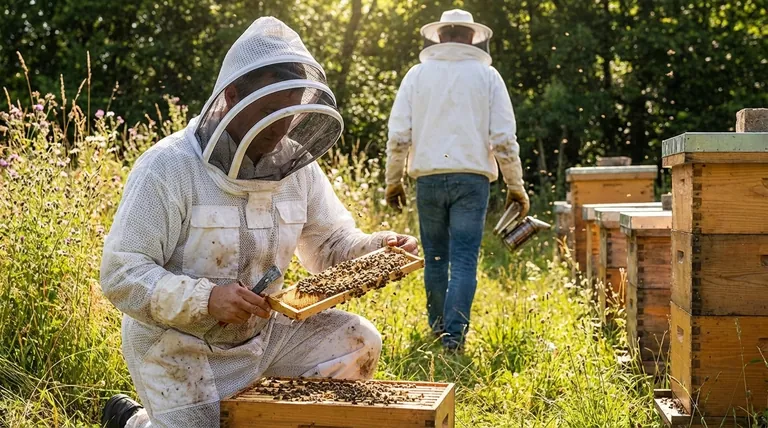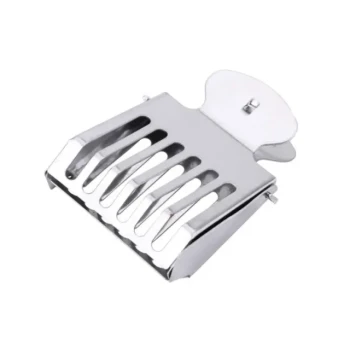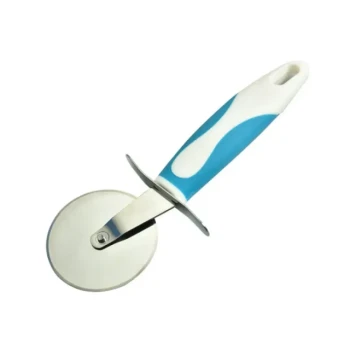No, a full beekeeping suit is not strictly necessary. While it offers the highest level of protection, many experienced beekeepers opt for a simpler setup, such as a beekeeping jacket with a veil combined with durable pants like jeans. The choice depends on a combination of your experience, comfort level, and the specific tasks you are performing.
The decision to wear a full bee suit is not a matter of necessity, but a strategic choice. It's about balancing the need for absolute protection against the practical realities of comfort, mobility, and the temperament of your specific bees.

The Core Purpose of Protective Gear
Before comparing options, it's essential to understand what beekeeping gear is designed to accomplish. Its primary function is to act as a shield, allowing you to work confidently and safely.
Protection Against Stings
The most obvious purpose is to prevent painful bee stings. This is especially critical for individuals who may have allergic reactions to bee venom, where a sting can pose a serious health risk.
Building Confidence
For new beekeepers, the fear of being stung can be a significant barrier. Proper protective gear minimizes this fear, allowing you to move calmly and deliberately, which in turn keeps the bees calmer.
Evaluating Your Options: Full Suit vs. Jacket
The two most common choices for upper-body protection are the full suit and the jacket/veil combination. Each serves a different need.
The Case for the Full Suit
A full, one-piece suit offers complete head-to-ankle protection. It ensures there are no gaps between your jacket and pants where a bee could enter.
This makes it the ideal choice for beginners, anyone with a known or suspected bee allergy, or when you anticipate a particularly invasive hive inspection.
The Case for the Jacket and Veil
A beekeeping jacket provides protection for your entire upper body and includes an integrated veil. It is worn with a separate pair of thick pants.
This setup is often preferred by experienced beekeepers for its convenience and comfort, especially for quick, routine hive checks.
Understanding the Trade-offs
Choosing your gear involves accepting a set of compromises. What you gain in one area, you may sacrifice in another.
The Downside of Full Suits
The primary drawback of a full suit is low ventilation. They can become extremely hot and uncomfortable, particularly during summer months.
Additionally, the sense of total invulnerability can sometimes lead to overconfidence, causing a beekeeper to be less gentle or careful than they otherwise would be.
The Risks of Minimal Gear
Opting for a jacket or even less protection inherently increases your exposure to stings, especially around the legs and ankles.
This approach requires a greater understanding of bee behavior and more confidence in your movements. It is generally not recommended until you have significant experience.
Key Factors Influencing Your Decision
Your personal context should guide your choice of protective gear. Consider these factors before working with your hives.
Your Experience Level
Beginner beekeepers are almost always advised to start with full protective gear. As you gain experience and become more comfortable, you can reassess what level of protection feels appropriate.
The Temperament of Your Bees
Honeybee colonies have distinct personalities. Some are exceptionally gentle, while others are more defensive. Your gear choice should adapt to the temperament of the specific hive you are working with.
The Nature of the Task
The task at hand matters. A quick check to refill a feeder is far less disruptive than a full hive inspection, a honey harvest, or managing a hive issue. Many beekeepers wear minimal gear for simple tasks and a full suit for more invasive work.
Making the Right Choice for Your Goal
Your primary objective will determine the best equipment for you.
- If your primary focus is maximum safety and confidence as a new beekeeper: Start with a well-fitting, full beekeeping suit to build your skills without fear.
- If your primary focus is comfort and efficiency for routine inspections: A quality beekeeping jacket with a veil and a good pair of jeans may be sufficient once you are experienced.
- If your primary focus is dealing with an unknown or defensive hive: Always default to a full suit, regardless of your experience level.
Ultimately, the right gear is what allows you to work calmly, confidently, and safely with your bees.
Summary Table:
| Protection Level | Best For | Key Considerations |
|---|---|---|
| Full Suit | Beginners, allergic beekeepers, invasive tasks | Maximum safety, can be hot, reduces mobility |
| Jacket & Veil | Experienced beekeepers, quick inspections | Better ventilation, increased risk of leg/ankle stings |
| Minimal Gear | Highly experienced beekeepers, gentle hives | Maximum mobility, requires high confidence and skill |
Equip yourself with confidence for every hive inspection. Whether you're a commercial apiary managing hundreds of hives or a distributor stocking for the season, HONESTBEE provides the durable, professional-grade beekeeping suits, jackets, and veils you need. Our wholesale-focused operations ensure you get the right protective gear for your specific challenges and budget.
Contact our team today to discuss your needs and request a wholesale catalog.
Visual Guide

Related Products
- 3 Layer Mesh Vented Sting Proof Beekeeping Suit with Hat and Veil
- Cotton Beekeeping Suit and Round Hat with Veil Bee Keeper Protective Gear
- Vented Beekeeping Jacket with Hood and Veil for Beekeepers
- Yellow Plastic Bucket Pail Perch for Beekeeping
- Long Langstroth Style Horizontal Top Bar Hive for Wholesale
People Also Ask
- What are the advantages of reinforced stitching and durable zippers in beekeeping suits? Ensure Maximum Safety & Longevity
- What should be considered when fitting beekeeping clothing? The Essential Guide to Safety & Comfort
- What should be considered regarding the color of beekeeping clothing? Ensure Your Safety and Keep Bees Calm
- What are the key features to look for in beekeeping clothing? Ensure Maximum Safety & Comfort
- What are the benefits of a fully ventilated beekeeping suit? Stay Cool and Protected in Hot Climates



















